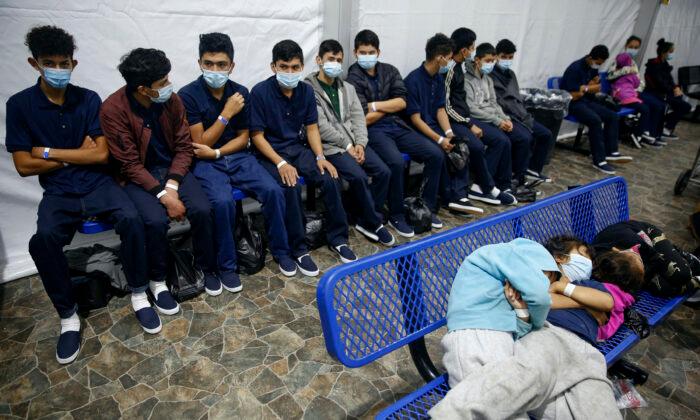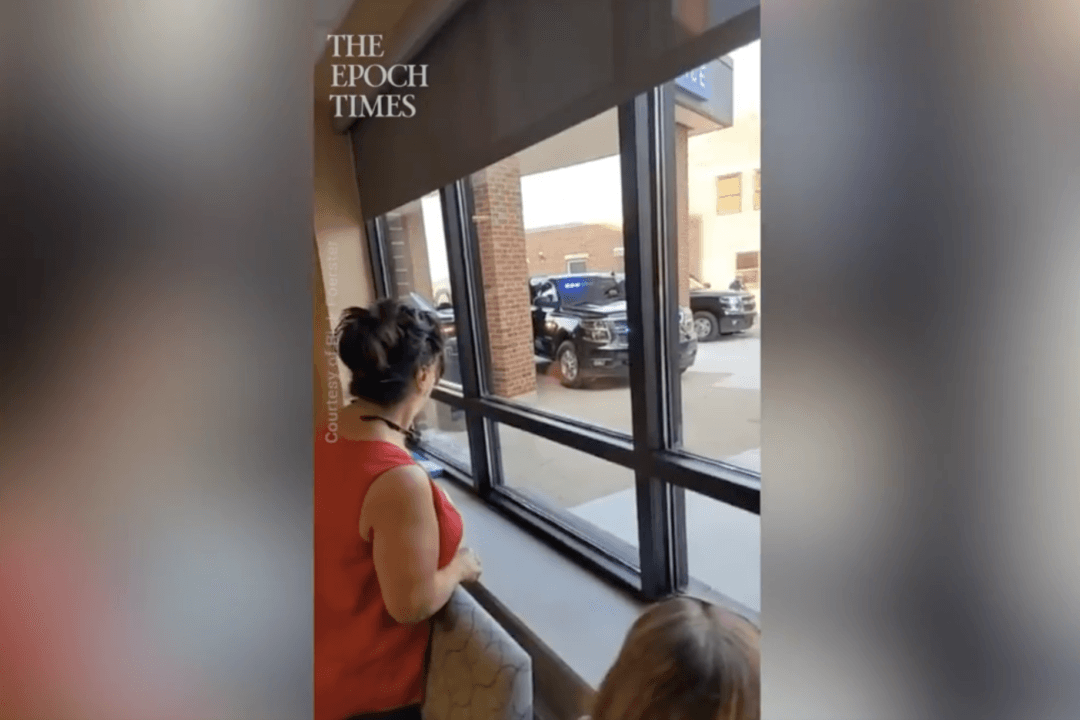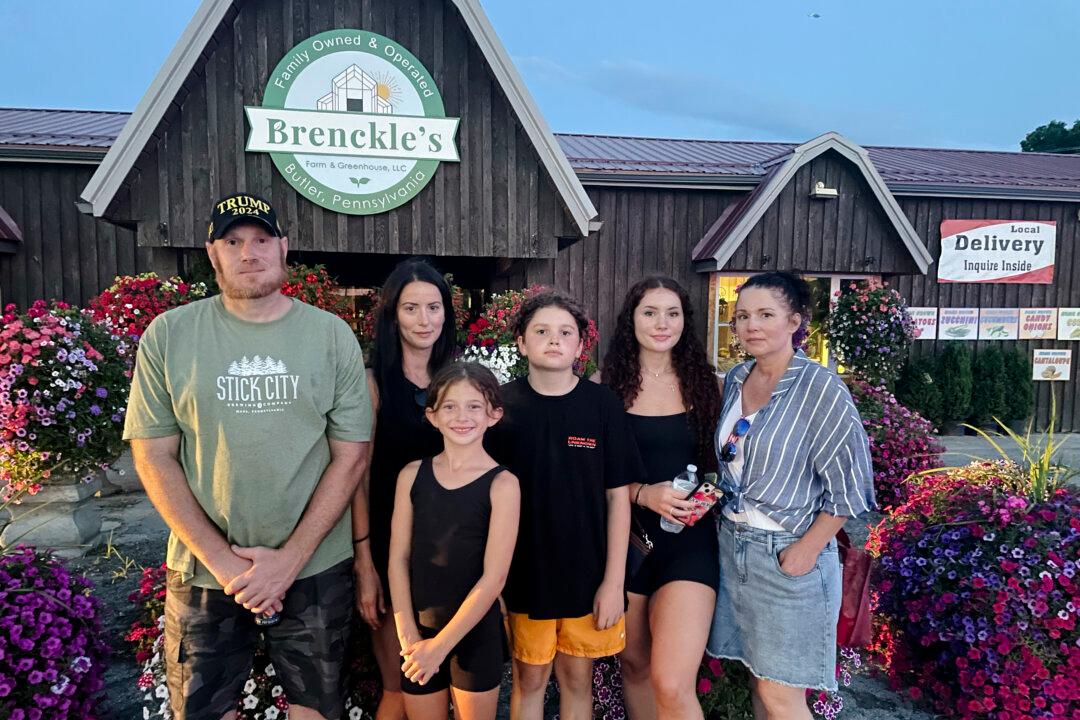Many are unaccompanied minors, and although the government has 296 Influx Care Facilities (ICFs) located in 27 states to house such minors, it doesn’t make clear precisely where the minors are sent.
When unaccompanied minors illegally cross into the United States and are apprehended by the U.S. Department of Homeland Security (DHS), they’re transferred to the custody of the Office of Refugee Resettlement (ORR), which is legally required to provide care for all unaccompanied children referred to it while their claims to immigration are processed or until they’re placed with a sponsor, which may be a parent or relative.
More Space Needed
As of May 5, there were 8,790 children in ORR care across the United States, but many more are expected, as Title 42 ended on May 11.“While ORR has worked to build up its licensed bed capacity, additional capacity is urgently needed to manage the increasing numbers of unaccompanied children referrals from DHS,” ORR stated on May 5 on its website.
“In preparation for the potential need for additional beds and to provide services and care that align with child welfare best practices, HHS [the Department of Health and Human Services] opened several [ICFs].
“ORR operates a network of 296 facilities/programs in 27 states and has a proven track record of accountability and transparency for program operations, as well as being a good neighbor in the communities where facilities are located.”
Planned Facilities
A future facility in Greensboro, North Carolina, is mentioned on the ORR website. The future Greensboro Piedmont Academy will provide shelter for boys and girls aged 13 to 17 and has a capacity of up to 800 beds. But no children are in care there yet, the statement said, and an opening date hasn’t been determined. When open, the academy will provide education, housing, mental health and medical care, and case management.Specifically, ICFs for unaccompanied minors must provide clean and comfortable sleeping quarters, meals, toiletries, laundry, educational and recreational activities, and access to medical services. Minors are tested for COVID-19 before being transported to the facility and every three days while in care. They’re given medical screenings and any follow-up care needed for any injuries or illnesses, according to ORR.
In March, news broke that Ehrenfeld Companies—the owner of the former two-year college for Mercyhurst University, Granite Ridge, in the borough of North East, Pennsylvania—was considering turning the property into housing for unaccompanied minors.
However, Rep. Mike Kelly (R-Pa.) and members of his office have been contacted by local leaders and residents expressing their objections to such a facility.
“There is a lot of concern from community members in North East about the prospect of an unaccompanied migrant facility in their town. We understand the talks between property owners and local officials remain ongoing and that it’s not a done deal just yet,” Matt Knoedler, Kelly’s spokesman, told The Epoch Times.
“So far, Representative Kelly and our staff remain in communication with all parties involved to remain up-to-date about the project’s future. We met with local officials and the property’s owners to learn more about the future of the project and what the impact of that project may be on the North East community.
“Many residents remain concerned about a repeat of what happened in Erie County in 2021, when a group of nearly 150 migrant children was suddenly placed in an emergency intake site without first telling community members or even Representative Kelly. It appears the 2021 case is fresh in the minds of North East residents as the debate over this new proposed facility continues.”
Granite Ridge didn’t respond by press time to a request by The Epoch Times for comment.
On April 5, 2021, HHS opened an Emergency Intake Site for Unaccompanied Children at the Target Lodge Pecos North property in Pecos, Texas. As of June 4, 2022, the site transitioned to an ICF that provided shelter for boys and girls aged 13 to 17.
Then, on March 11, 2023, the facility was placed in warm status, which means that the facility isn’t fully staffed, with only minimal onsite facility management services, such as payment of utilities, infrastructure repairs, and fence, landscaping, and storm damage preparation.
Not All Minors
Between 2012 and 2022, unaccompanied minors entering the United States each year were mostly teenage boys from Guatemala, according to ORR statistics. In 2022, the ORR received 128,904 minors from the DHS. Of those, 47 percent were from Guatemala, followed by 29 percent from Honduras, 13 percent from El Salvador, 3 percent from Mexico, and 8 percent from all other countries.Last year, 36 percent of captured unaccompanied minors were female and 64 percent were male; 15 percent were aged 12 or younger, 13 percent were aged 13 to 14, 36 percent were aged 15 to 16, and 36 percent were 17 or older.
That is, 72 percent were aged 15 or older, and 28 percent were aged 14 or younger.
“I would not want one of these facilities in my neighborhood because regardless of whether the kids commit any crimes, it’s a magnet for criminals. They attract everything from gangs to human traffickers,” Matthew O’Brien, director of investigations at the Immigration Reform Law Institute, told The Epoch Times.
“These are being portrayed as something like a group home or a foster home. But they really need to be run more like a juvenile detention facility because the other problem is, most of these kids—by the time they’re put into this procedure—have not had background checks run on them. It’s a problem vetting minors in general, but particularly minor aliens. So we don’t know how many of these kids have had interactions with the criminal justice system in their home countries.”
O’Brien was appointed by former President Donald Trump and worked as an immigration judge and ran the National Security Division of U.S. Citizenship and Immigration Services during the Trump administration. He said a lot of unaccompanied minors aren’t minors at all; they fake their age to get into the program, which often ends with a green card.
When he was a judge, he said he saw instances of people who were 27 years old posing as minors and being put in U.S. high schools.
“Gang membership in Latin America regularly starts with kids as young as 8 to 10 years old. The program has been infected with gang members,” O’Brien said. “Gangs aren’t stupid. They know that this is also fertile ground for recruitment. Trafficking is another problem.
“A trafficker shows up and says, ‘This is my cousin’s kid. I’m a family member.’ And of course, the child knows that they need to say yes to that because if the child doesn’t, the child will be severely punished.”
He also said that once minors leave the facility, HHS has no idea what happens to them.
“HHS doesn’t have any staff to monitor the so-called sponsors,“ O'Brien said. ”There’s nobody doing random home visits. U.S. Citizenship and Immigration Services is not having their Fraud Detection and National Security Division look into any of this. So the whole thing is a disaster.”
In this way, he says, the United States has become the largest human trafficker of children in the world.
In April, ORR Director Robin Dunn Marcos was questioned in Congress about why 85,000 unaccompanied minors from the border have been reported missing in the past two years. She was unable to answer.
“People send their children here in hopes that they are somehow going to serve as an anchor for adult family members to later come here,” O’Brien said.
“People have been misled by leftists, to believe that the ideal life for their children is living in a place where everything is given to them for free. There is a perception that, in the United States, if you show up and stay here long enough, you will be able to—either from state governments or from the federal government—get free health care, free education, free housing, food stamps, etc.
The Cost
Spending on illegal immigration by unaccompanied children has increased greatly in recent years, federal records show, costing taxpayers:- $1.3 billion in 2017
- $1.9 billion in 2018
- $2.6 billion in 2019
- $2.1 billion in 2020 under COVID-19 restrictions
- $6.8 billion in 2021
- $7.8 billion in 2022—a new spending record
- $3 billion in 2023 to date
The Contracts
While ORR and HHS haven’t provided a list of ICFs across the United States, some can be found through government documents. Some of them are:- Cayuga Home For Children in Auburn, New York
- Florida Department of Children and Families (multiple locations)
- Sunny Glen Children’s Home in San Benito, Texas
- Youth for Tomorrow in Bristow, Virginia
- Ethiopian Community Development Council in Arlington, Virginia
- Kidspeace Corporation based in Schnecksville, Pennsylvania
- Rising Ground Inc., Kingston, New York
- Maryville Academy, Des Plaines, Illinois
- Rite of Passage, Minden, Nevada
- The Devereux Foundation, based in West Chester, Pennsylvania (multiple locations)
- Commonwealth of Massachusetts (multiple locations)
- Berkshire Farm Center and Services for Youth, Canaan, New York
- Ohio Department of Job and Family Services (multiple locations)
- Visionquest National, Tucson, Arizona
- Mercyfirst, Syosset, New York
- Michigan Department of Labor and Economic Opportunity (multiple locations)
- Department Of Human Services Colorado (multiple locations)
- New Life Foster Family Agency in Glendora, California
- Polaris Project, Washington, D.C.
- Friends of Youth, Kirkland, Washington
- Nebraska Department of Health & Human Services (multiple locations)
- Pennsylvania Department of Human Services
- Shenandoah Valley Juvenile Detention Home, Staunton, Virginia
- A New Leaf, Inc., Mesa, Arizona (multiple locations)
- North Dakota Department of Human Services
- State of Wisconsin Department of Children and Families
- Noank Community Support Services, Groton, Connecticut
- Asian Services in Action, Inc., Akron, Ohio (multiple locations)
- Human Services, Rhode Island
- Catholic Charities Maine
- Georgia Department of Human Services
- Mississippi Department of Human Services
- International Institute of Metropolitan St. Louis, Missouri (multiple locations)





